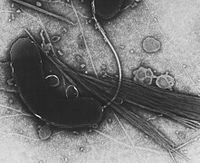
Photo from wikipedia
Abstract Betaproteobacteria include some of the most abundant and ubiquitous bacterial genera that can be found in drinking water, including mineral water. The combination of physiology and ecology traits place… Click to show full abstract
Abstract Betaproteobacteria include some of the most abundant and ubiquitous bacterial genera that can be found in drinking water, including mineral water. The combination of physiology and ecology traits place some Betaproteobacteria in the list of potential, yet sometimes neglected, opportunistic pathogens that can be transmitted by water or aqueous solutions. Indeed, some drinking water Betaproteobacteria with intrinsic and sometimes acquired antibiotic resistance, harbouring virulence factors and often found in biofilm structures, can persist after water disinfection and reach the consumer. This literature review summarises and discusses the current knowledge about the occurrence and implications of Betaproteobacteria in drinking water. Although the sparse knowledge on the ecology and physiology of Betaproteobacteria thriving in tap or bottled natural mineral/spring drinking water (DW) is an evidence of this review, it is demonstrated that DW holds a high diversity of Betaproteobacteria, whose presence may not be innocuous. Frequently belonging to genera also found in humans, DW Betaproteobacteria are ubiquitous in different habitats, have the potential to resist antibiotics either due to intrinsic or acquired mechanisms, and hold different virulence factors. The combination of these factors places DW Betaproteobacteria in the list of candidates of emerging opportunistic pathogens. Improved bacterial identification of clinical isolates associated with opportunistic infections and additional genomic and physiological studies may contribute to elucidate the potential impact of these bacteria.
Journal Title: Critical Reviews in Microbiology
Year Published: 2019
Link to full text (if available)
Share on Social Media: Sign Up to like & get
recommendations!